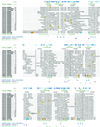Structure of a functional IGF2R fragment determined from the anomalous scattering of sulfur
- PMID: 11867533
- PMCID: PMC125895
- DOI: 10.1093/emboj/21.5.1054
Structure of a functional IGF2R fragment determined from the anomalous scattering of sulfur
Abstract
Insulin-like growth factor II receptor (IGF2R) is a multifunctional cell surface receptor implicated in tumour suppression. Its growth inhibitory activity has been associated with an ability to bind IGF-II. IGF2R contains 15 homologous extracellular domains, with domain 11 primarily responsible for IGF-II binding. We report a 1.4 A resolution crystal structure of domain 11, solved using the anomalous scattering signal of sulfur. The structure consists of two crossed beta-sheets forming a flattened beta-barrel. Structural analysis identifies the putative IGF-II binding site at one end of the beta-barrel whilst crystal lattice contacts suggest a model for the full-length IGF2R extracellular region. The structure factors and coordinates of IGF2R domain 11 have been deposited in the Protein Data Bank (accession codes 1GP0 and 1GP3).
Figures






Similar articles
-
Structure and function of the human Gly1619Arg polymorphism of M6P/IGF2R domain 11 implicated in IGF2 dependent growth.J Mol Endocrinol. 2009 Apr;42(4):341-56. doi: 10.1677/JME-08-0154. Epub 2009 Feb 10. J Mol Endocrinol. 2009. PMID: 19208780 Free PMC article.
-
Kinetics of insulin-like growth factor II (IGF-II) interaction with domain 11 of the human IGF-II/mannose 6-phosphate receptor: function of CD and AB loop solvent-exposed residues.J Mol Biol. 2006 Jun 2;359(2):403-21. doi: 10.1016/j.jmb.2006.03.046. Epub 2006 Apr 6. J Mol Biol. 2006. PMID: 16631789
-
A novel binding site for the human insulin-like growth factor-II (IGF-II)/mannose 6-phosphate receptor on IGF-II.J Biol Chem. 2007 Jun 29;282(26):18886-94. doi: 10.1074/jbc.M700531200. Epub 2007 May 2. J Biol Chem. 2007. PMID: 17475626
-
Keeping IGF-II under control: lessons from the IGF-II-IGF2R crystal structure.Trends Biochem Sci. 2009 Dec;34(12):612-9. doi: 10.1016/j.tibs.2009.07.003. Epub 2009 Sep 30. Trends Biochem Sci. 2009. PMID: 19796953 Review.
-
Interactions of IGF-II with the IGF2R/cation-independent mannose-6-phosphate receptor mechanism and biological outcomes.Vitam Horm. 2009;80:699-719. doi: 10.1016/S0083-6729(08)00625-0. Vitam Horm. 2009. PMID: 19251056 Review.
Cited by
-
Structure of the fungal beta-glucan-binding immune receptor dectin-1: implications for function.Protein Sci. 2007 Jun;16(6):1042-52. doi: 10.1110/ps.072791207. Epub 2007 May 1. Protein Sci. 2007. PMID: 17473009 Free PMC article.
-
Blockade of IGF2R improves muscle regeneration and ameliorates Duchenne muscular dystrophy.EMBO Mol Med. 2020 Jan 9;12(1):e11019. doi: 10.15252/emmm.201911019. Epub 2019 Dec 2. EMBO Mol Med. 2020. PMID: 31793167 Free PMC article.
-
Insulin-Like Growth Factor-II/Cation-Independent Mannose 6-Phosphate Receptor in Neurodegenerative Diseases.Mol Neurobiol. 2017 May;54(4):2636-2658. doi: 10.1007/s12035-016-9849-7. Epub 2016 Mar 19. Mol Neurobiol. 2017. PMID: 26993302 Free PMC article. Review.
-
Heterotrimeric G proteins and the single-transmembrane domain IGF-II/M6P receptor: functional interaction and relevance to cell signaling.Mol Neurobiol. 2007 Jun;35(3):329-45. doi: 10.1007/s12035-007-0021-2. Mol Neurobiol. 2007. PMID: 17917122 Review.
-
Keys to the hidden treasures of the mannose 6-phosphate/insulin-like growth factor 2 receptor.Am J Pathol. 2003 Jan;162(1):3-6. doi: 10.1016/S0002-9440(10)63791-1. Am J Pathol. 2003. PMID: 12507883 Free PMC article. No abstract available.
References
-
- Brünger A.T. et al. (1998) Crystallography and NMR system: A new software suite for macromolecular structure determination. Acta Crystallogr. D, 54, 905–921. - PubMed
-
- Burns J.L. and Hassan,A.B. (2001) Cell survival and proliferation are modified by insulin-like growth factor 2 between days 9 and 10 of mouse gestation. Development, 128, 3819–3830. - PubMed
-
- Byrd J.C., Devi,G.R., de Souza,A.T., Jirtle,R.L. and MacDonald,R.G. (1999) Disruption of ligand binding to the insulin-like growth factor II/mannose 6-phosphate receptor by cancer-associated missense mutations. J. Biol. Chem., 274, 24408–24416. - PubMed
-
- Byrd J.C., Park,J.H., Schaffer,B.S., Garmroudi,F. and MacDonald,R.G. (2000) Dimerization of the insulin-like growth factor II/mannose 6-phosphate receptor. J. Biol. Chem., 275, 18647–18656. - PubMed
-
- Dahms N.M., Rose,P.A., Molkentin,J.D., Zhang,Y. and Brzycki,M.A. (1993) The bovine mannose 6-phosphate/insulin-like growth factor II receptor. The role of arginine residues in mannose 6-phosphate binding. J. Biol. Chem., 268, 5457–5463. - PubMed
Publication types
MeSH terms
Substances
Associated data
- Actions
- Actions
- Actions
LinkOut - more resources
Full Text Sources
Other Literature Sources
Miscellaneous

